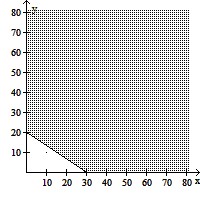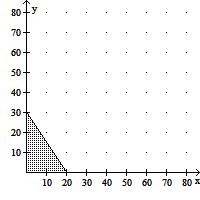Solve the problem.Jason bought x rose plants and y sunflower plants for his garden. Rose plants cost $8 each, and sunflower plants cost $12 each. If his spending limit was $240., (a) write an inequality to show the possible combinations of rose plants and sunflower plants he could have bought. (b) Graph the inequality. Because x and y must be non-negative, restrict the graph to Quadrant I. (c) Can Jason afford to buy 25 rose plants and 15 sunflowers plants?
A. (a) 8x + 12y ? 240
(b)
(c) yes
B. (a) 12x + 8y ? 240
(b)
(c) no
C. (a) 8x + 12y ? 240
(b)
(c) no
D. (a) 12x + 8y ? 240
(b)
(c) yes
Answer: C
You might also like to view...
Determine whether the following is always true or not always true. Given reasons for your answers.(u × v) ? w = u ? (w × v)
What will be an ideal response?
Find an equation for the tangent to the curve at the given point.f(x) = 4 - x + 3, (16, 3)
- x + 3, (16, 3)
A. y =  x - 11
x - 11
B. y = 3
C. y = -  x + 3
x + 3
D. y = -  x + 11
x + 11
Solve the problem.You are purchasing a home for $220,000 and are shopping for a loan. You have a total of $40,000 to put down. In addition, there are $800 in closing costs loan and any loan fee that might be charged. Bank A offers a 10% APR amortized over 20 years with 240 equal monthly payments. There is no loan fee. Bank B offers an 8.5% APR amortized over 20 years with 240 equal monthly payments. There is a 4% loan fee (i.e., a one-time up-front charge of 4% of the loan). Calculate the monthly mortgage payment of both loans and identify which is the better loan.
A. Bank A: $1737; Bank B: $1562; Bank B offers a better loan B. Bank A: $1745; Bank B: $1569; Bank A offers a better loan C. Bank A: $1737; Bank B: $1562; Bank A offers a better loan D. Bank A: $1745; Bank B: $1569; Bank B offers a better loan E. Bank A: $2123; Bank B: $1909; Bank B offers a better loan
To draw an ellipse that is 20 centimeters wide and 8 centimeters tall, how far apart should the two thumbtacks be? ?
A. 8 cm B. 17.8 cm C. 20 cm D. 18.3 cm E. none of these